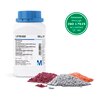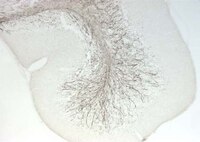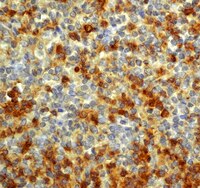Progesterone enhances vascular endothelial cell migration via activation of focal adhesion kinase.
Shuhui Zheng,Jinghe Huang,Kewen Zhou,Qiuling Xiang,Yaxing Zhang,Zhi Tan,Tommaso Simoncini,Xiaodong Fu,Tinghuai Wang
Journal of cellular and molecular medicine
16
2012
Show Abstract
The mechanisms of progesterone on endothelial cell motility are poorly investigated. Previously we showed that progesterone stimulated endothelial cell migration via the activation of actin-binding protein moesin, leading to actin cytoskeleton remodelling and the formation of cell membrane structures required for cell movement. In this study, we investigated the effects of progesterone on the formation of focal adhesion complexes, which provide anchoring sites for cell movement. In cultured human umbilical endothelial cells, progesterone enhanced focal adhesion kinase (FAK) phosphorylation at Tyr(397) in a dose- and time-dependent manner. Several signalling inhibitors interfered with progesterone-induced FAK activation, including progesterone receptor (PR) antagonist ORG 31710, specific c-Src kinase inhibitor PP2, phosphatidylinosital-3 kinase (PI3K) inhibitor wortmannin as well as ρ-associated kinase (ROCK-2) inhibitor Y27632. It suggested that PR, c-Src, PI3K and ROCK-2 are implicated in this action. In line with this, we found that progesterone rapidly promoted c-Src/PI3K/Akt activity, which activated the small GTPase RhoA/ρ-associated kinase (ROCK-2) complex, resulting in FAK phosphorylation. In the presence of progesterone, endothelial cells displayed enhanced horizontal migration, which was reversed by small interfering RNAs abrogating FAK expression. In conclusion, progesterone promotes endothelial cell movement via the rapid regulation of FAK. These findings provide new information on the biological actions of progesterone on human endothelial cells that are relevant for vascular function. | | 21418517
 |
17β-Estradiol enhances breast cancer cell motility and invasion via extra-nuclear activation of actin-binding protein ezrin.
Zheng, S; Huang, J; Zhou, K; Zhang, C; Xiang, Q; Tan, Z; Wang, T; Fu, X
PloS one
6
e22439
2011
Show Abstract
Estrogen promotes breast cancer metastasis. However, the detailed mechanism remains largely unknown. The actin binding protein ezrin is a key component in tumor metastasis and its over-expression is positively correlated to the poor outcome of breast cancer. In this study, we investigate the effects of 17β-estradiol (E2) on the activation of ezrin and its role in estrogen-dependent breast cancer cell movement. In T47-D breast cancer cells, E2 rapidly enhances ezrin phosphorylation at Thr(567) in a time- and concentration-dependent manner. The signalling cascade implicated in this action involves estrogen receptor (ER) interaction with the non-receptor tyrosine kinase c-Src, which activates the phosphatidylinositol-3 kinase/Akt pathway and the small GTPase RhoA/Rho-associated kinase (ROCK-2) complex. E2 enhances the horizontal cell migration and invasion of T47-D breast cancer cells in three-dimensional matrices, which is reversed by transfection of cells with specific ezrin siRNAs. In conclusion, E2 promotes breast cancer cell movement and invasion by the activation of ezrin. These results provide novel insights into the effects of estrogen on breast cancer progression and highlight potential targets to treat endocrine-sensitive breast cancers. | | 21818323
 |
Vascular endothelial growth factor C promotes cervical cancer metastasis via up-regulation and activation of RhoA/ROCK-2/moesin cascade.
He, M; Cheng, Y; Li, W; Liu, Q; Liu, J; Huang, J; Fu, X
BMC cancer
10
170
2010
Show Abstract
The elevated expression of vascular endothelial growth factor C (VEGF-C) is correlated with clinical cervical cancer metastasis and patient survival, which is interpreted by VEGF-C functions to stimulate angiogenesis and lymphatic genesis. However, the direct impact of VEGF-C on cervical cancer cell motility remains largely unknown.In this study, we investigated the effects of VEGF-C on actin cytoskeleton remodeling and on cervical cancer cell migration and invasion and how the actin-regulatory protein, moesin regulated these effects through RhoA/ROCK-2 signaling pathway.On cervical carcinoma cell line SiHa cells, exposure of VEGF-C triggered remodeling of the actin cytoskeleton and the formation of membrane ruffles, which was required for cell movement. VEGF-C significantly enhanced SiHa cells horizontal migration and three-dimensional invasion into matrices. These actions were dependent on increased expression and phosphorylation of the actin-regulatory protein moesin and specific moesin siRNA severely impaired VEGF-C stimulated-cell migration. The extracellular small GTPase RhoA/ROCK-2 cascade mediated the increased moesin expression and phosphorylation, which was discovered by the use of Y-27632, a specific inhibitor of Rho kinase and by transfected constitutively active, dominant-negative RhoA as well as ROCK-2 SiRNA. Furthermore, in the surgical cervical specimen from the patients with FIGO stage at cervical intra-epithelial neoplasia and I-II cervical squamous cell carcinoma, the expression levels of moesin were found to be significantly correlated with tumor malignancy and metastasis.These results implied that VEGF-C promoted cervical cancer metastasis by upregulation and activation of moesin protein through RhoA/ROCK-2 pathway. Our findings offer new insight into the role of VEGF-C on cervical cancer progression and may provide potential targets for cervical cancer therapy. Full Text Article | Western Blotting | 20429915
 |
Progesterone receptor enhances breast cancer cell motility and invasion via extranuclear activation of focal adhesion kinase.
Fu, XD; Goglia, L; Sanchez, AM; Flamini, M; Giretti, MS; Tosi, V; Genazzani, AR; Simoncini, T
Endocrine-related cancer
17
431-43
2010
Show Abstract
While progesterone plays multiple roles in the process of breast development and differentiation, its role in breast cancer is less understood. We have shown previously that progestins stimulate breast cancer cell migration and invasion because of the activation of rapid signaling cascades leading to modifications in the actin cytoskeleton and cell membrane that are required for cell movement. In this study, we have investigated the effects of progesterone on the formation of focal adhesion (FA) complexes, which provide anchoring sites for cell attachment to the extracellular matrix during cell movement and invasion. In T47-D breast cancer cells, progesterone rapidly enhances FA kinase (FAK) phosphorylation at Tyr(397) in a time- and concentration-dependent manner. As a result, exposure to progesterone leads to increased formation of FA complexes within specialized cell membrane protrusions. The cascade of events required for this phenomenon involves progesterone receptor interaction with the tyrosine kinase c-Src, which activates the phosphatidylinositol-3-kinase/Akt pathway and the small GTPase RhoA/Rho-associated kinase complex. In the presence of progesterone, T47-D breast cancer cells display enhanced horizontal migration and invasion of three-dimensional matrices, which is reversed by small interfering RNAs abrogating FAK. In conclusion, progesterone promotes breast cancer cell movement and invasion by facilitating the formation of FA complexes via the rapid regulation of FAK. These results provide novel mechanistic views on the effects of progesterone on breast cancer progression, and may in the future be helpful to develop new strategies for the treatment of endocrine-sensitive breast cancers. | Western Blotting | 20233709
 |
Differential actions of estrogen and SERMs in regulation of the actin cytoskeleton of endometrial cells.
Flamini, M I, et al.
Mol. Hum. Reprod., 15: 675-85 (2009)
2009
Show Abstract
Estrogen and selective estrogen receptor modulators (SERMs) differentially impact endometrial cell function, however, the biological basis of these differences is not established. Deregulated cell adhesion to the extracellular matrix, cell movement and invasion are related to endometrial disorders, such as endometriosis or endometrial cancer. Remodeling of the actin cytoskeleton is required to achieve cell adhesion and movement. Estrogen receptor (ER) regulates actin and cell membrane remodeling through extra-nuclear signaling cascades. In this article, we show that administration of 17beta-estradiol (E2) and tamoxifen (TAM) to immortalized Ishikawa endometrial cells or to human endometrial stromal cells (ESC) results in remodeling of actin fibers and cell membrane. This is linked to rapid phosphorylation on Thr(558) of the actin-binding protein moesin and enhanced migration and invasion of normal and Ishikawa cells. Raloxifene (RAL) does not result in moesin activation or actin remodeling. When endometrial cells are exposed to E2 in the presence of TAM or RAL, both SERMs interfere with the recruitment of moesin, with the remodeling of the cytoskeleton, and with cell movement and migration induced by E2. The differential actions of E2, TAM and RAL are linked to a distinct modulation of the extra-nuclear signaling of ER to G proteins and to the Rho-associated kinase. These findings increase our understanding of the actions of estrogen and SERMs in endometrial cells and highlight potential molecular targets to interfere with the estrogen-related altered cell adhesion encountered in endometrial disorders. | | 19541800
 |
Extra-nuclear signaling of progesterone receptor to breast cancer cell movement and invasion through the actin cytoskeleton.
Fu, XD; Giretti, MS; Baldacci, C; Garibaldi, S; Flamini, M; Sanchez, AM; Gadducci, A; Genazzani, AR; Simoncini, T
PloS one
3
e2790
2008
Show Abstract
Progesterone plays a role in breast cancer development and progression but the effects on breast cancer cell movement or invasion have not been fully explored. In this study, we investigate the actions of natural progesterone and of the synthetic progestin medroxyprogesterone acetate (MPA) on actin cytoskeleton remodeling and on breast cancer cell movement and invasion. In particular, we characterize the nongenomic signaling cascades implicated in these actions. T47-D breast cancer cells display enhanced horizontal migration and invasion of three-dimensional matrices in the presence of both progestins. Exposure to the hormones triggers a rapid remodeling of the actin cytoskeleton and the formation of membrane ruffles required for cell movement, which are dependent on the rapid phosphorylation of the actin-regulatory protein moesin. The extra-cellular small GTPase RhoA/Rho-associated kinase (ROCK-2) cascade plays central role in progesterone- and MPA-induced moesin activation, cell migration and invasion. In the presence of progesterone, progesterone receptor A (PRA) interacts with the G protein G alpha(13), while MPA drives PR to interact with tyrosine kinase c-Src and to activate phosphatidylinositol-3 kinase, leading to the activation of RhoA/ROCK-2. In conclusion, our findings manifest that progesterone and MPA promote breast cancer cell movement via rapid actin cytoskeleton remodeling, which are mediated by moesin activation. These events are triggered by RhoA/ROCK-2 cascade through partially differing pathways by the two compounds. These results provide original mechanistic explanations for the effects of progestins on breast cancer progression and highlight potential targets to treat endocrine-sensitive breast cancers. Full Text Article | Immunoblotting (Western) | 18665217
 |
The receptor for advanced glycation end-products (RAGE) directly binds to ERK by a D-domain-like docking site.
Katsuya Ishihara, Kae Tsutsumi, Shiho Kawane, Motowo Nakajima, Tatsuhiko Kasaoka
FEBS letters
550
107-13
2003
Show Abstract
The receptor for advanced glycation end-products (RAGE)-mediated cellular activation through the mitogen-activated protein kinase (MAPK) cascade, activation of NF-kappaB and Rho family small G-proteins, cdc42/Rac, is implicated in the pathogenesis of inflammatory disorders and tumor growth/metastasis. However, the precise molecular mechanisms for the initiation of cell signaling by RAGE remain to be elucidated. In this study, proteins which directly bind to the cytoplasmic C-terminus of RAGE were purified from rat lung extracts using an affinity chromatography technique and identified to be extracellular signal-regulated protein kinase-1 and -2 (ERK-1/2). Their interactions were confirmed by immunoprecipitation of ERK-1/2 from RAGE-expressing HT1080 cell extracts with anti-RAGE antibody. Furthermore, the augmentation of kinase activity of RAGE-bound ERK upon the stimulation of cells with amphoterin was demonstrated by determining the phosphorylation level of myelin basic protein, an ERK substrate. In vitro binding studies using a series of C-terminal deletion mutants of human RAGE revealed the importance of the membrane-proximal cytoplasmic region of RAGE for the direct ERK-RAGE interaction. This region contained a sequence similar to the D-domain, a ERK docking site which is conserved in some ERK substrates including MAPK-interacting kinase-1/2, mitogen- and stress-activated protein kinase-1, and ribosomal S6 kinase. These data suggest that ERK may play a role in RAGE signaling through direct interaction with RAGE. | | 12935895
 |
A green fluorescent protein kinase substrate allowing detection and localization of intracellular ERK/MAP kinase activity.
Mandell, J W and Gocan, N C
Anal. Biochem., 293: 264-8 (2001)
2001
Show Abstract
We describe a versatile intracellular reporter of ERK/MAP kinase activity: a cDNA construct, pGFP.MBP, encoding amino acids 85-144 of the human myelin basic protein fused to the C-terminus of an enhanced green fluorescent protein (GFP). The fused fragment of myelin basic protein contains a single consensus ERK/MAP kinase phosphorylation motif (PRTP, where the threonine is phosphorylated). Phosphorylation of the specific motif can be detected via immunoblotting or immunofluorescence with a commercially available phospho-specific monoclonal antibody. When expressed in mammalian cells by either transient or stable transfection, the fusion protein acts as a bona fide kinase substrate, as demonstrated by rapid serum-induced phosphorylation that is blocked by a specific MEK inhibitor. Moreover, the localization of the total substrate pool is easily visualized by GFP autofluorescence and the extent of its phosphorylation simultaneously detected within intact fixed cells by immunofluorescence using the commercially available phospho-specific antibody. The approach described should be generally applicable to the intracellular analysis of many specific protein kinase substrates for which phospho-specific antibodies have been produced. | Immunofluorescence | 11399042
 |
Identification of a mitogen-activated protein kinase site in human myelin basic protein in situ.
Yon, M, et al.
J. Neuroimmunol., 65: 55-9 (1996)
1996
Show Abstract
Ultrastructural localization of a specific phosphorylated isomer of myelin basic protein (MBP) has been achieved with a monoclonal antibody specific for human MBP sequence, 89-105, in which Thr98 was phosphorylated. Cryosections of human brain white matter revealed that gold particles were found localized almost exclusively to the major dense line demonstrating that threonine 98 in the sequence Thr-Pro-Arg-Thr-Pro-Pro-Pro, a mitogen-activated protein kinase-specific site, was phosphorylated in vivo. In two cases of multiple sclerosis, the density of gold particles in myelin was reduced by about 30%, in one case by 42%, and by 80% in a fourth case. However, gold labelling was seen in areas of demyelination suggesting that the phosphorylated threonyl peptide was protected from degradation. | | 8642064
 |
Preparation of a novel monoclonal antibody specific for myelin basic protein phosphorylated on Thr98.
Yon, M, et al.
J. Neuroimmunol., 58: 121-9 (1995)
1995
Show Abstract
Phosphorylation is one of a number of post-translational modifications resulting in charge microheterogeneity of myelin basic protein (MBP). This phosphorylation is claimed to destabilise the compact myelin sheath by decreasing the interaction of membrane bilayers, thereby creating or maintaining pockets of cytoplasm. To further investigate and localise MBP phosphorylation to discrete regions of the myelin sheath we raised a monoclonal antibody with specificity for a known phosphorylation site in MBP. A synthetic peptide was made by Fmoc peptide chemistry and phosphorylation of Thr98 was achieved on the resin by the global phosphorylation methodology, utilising dibenzyl-N,N-diethylphosphoramidite phosphitylation and t-butylhydroperoxide oxidation. The peptide coupled to tuberculin was used to immunise mice for monoclonal antibody production. The selected hybridoma (Clone P12) secreted an IgG2a antibody which reacted strongly with the phosphorylated immunogen and with phosphorylated fractions of bovine MBP obtained by ion exchange chromatography. The antibody had minimal reactivity with the unphosphorylated peptide; the same peptide phosphorylated at another site Ser102; a preparation of unphosphorylated MBP obtained by ion exchange chromatography; and with an irrelevant phosphorylated protein (histone). Similar phosphorylation state-specific monoclonal antibodies could be made to recognise other specific phosphorylation sites in MBP or other proteins. It is planned to use these antibodies to quantify and locate the extent of MBP phosphorylation in normal and multiple sclerosis myelin. | | 7759601
 |
























